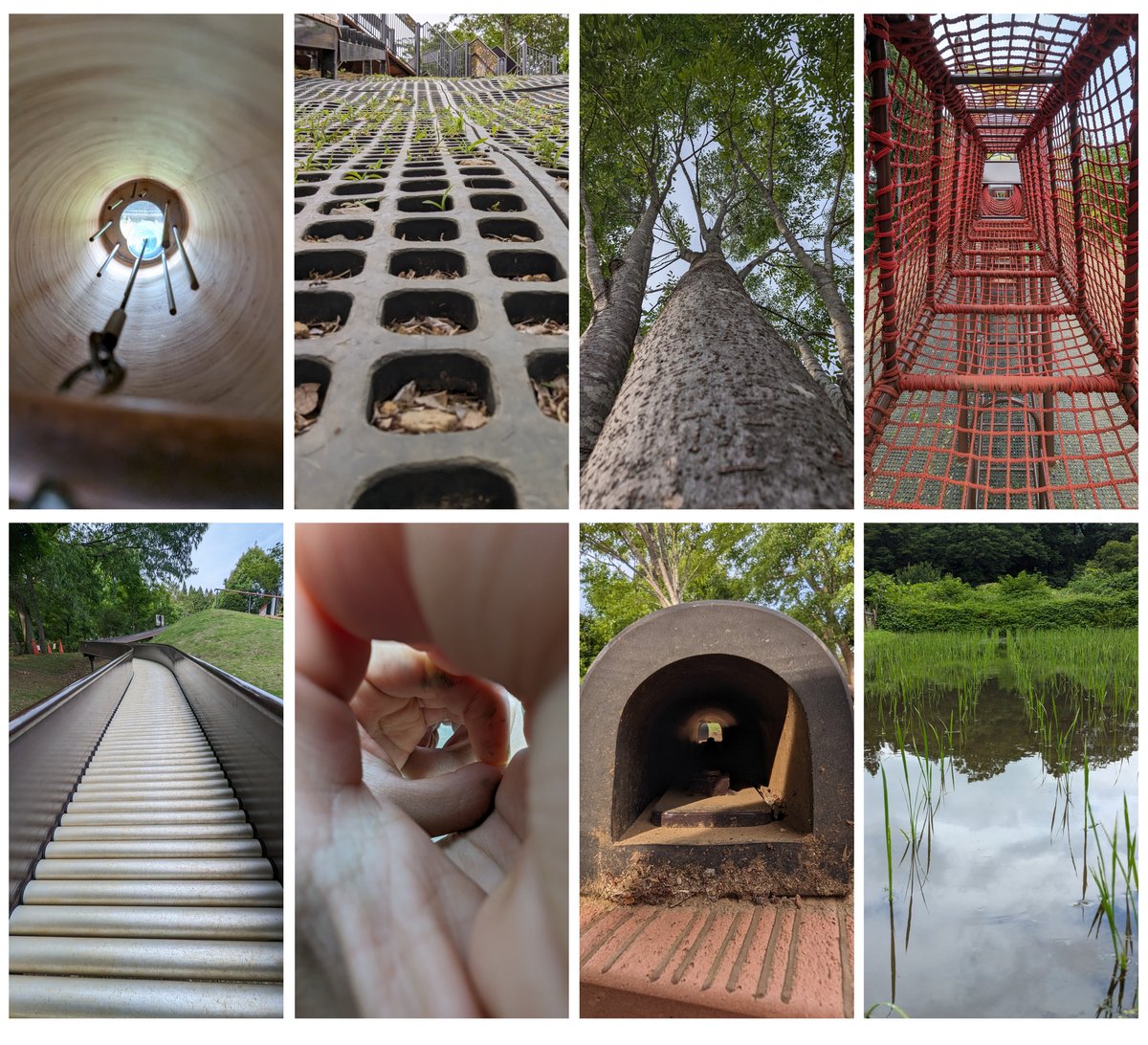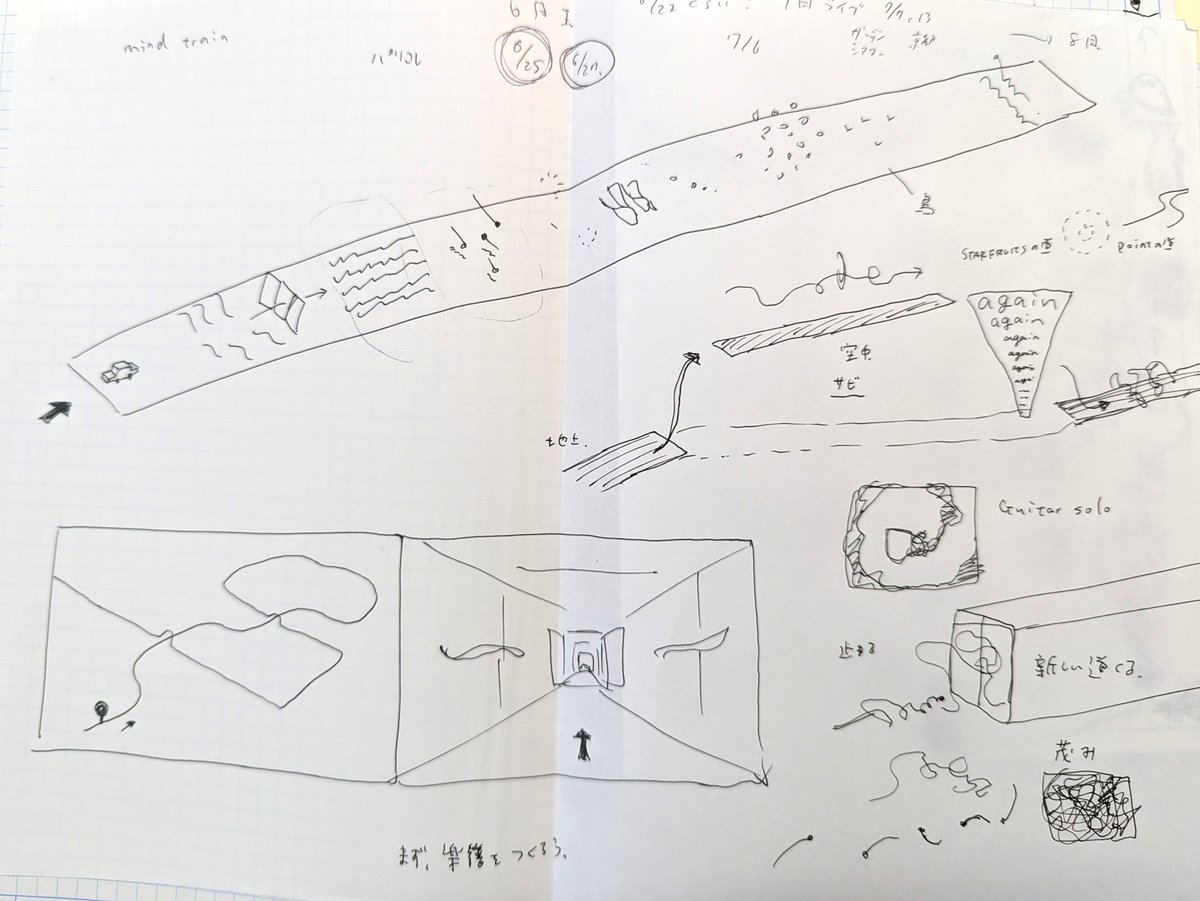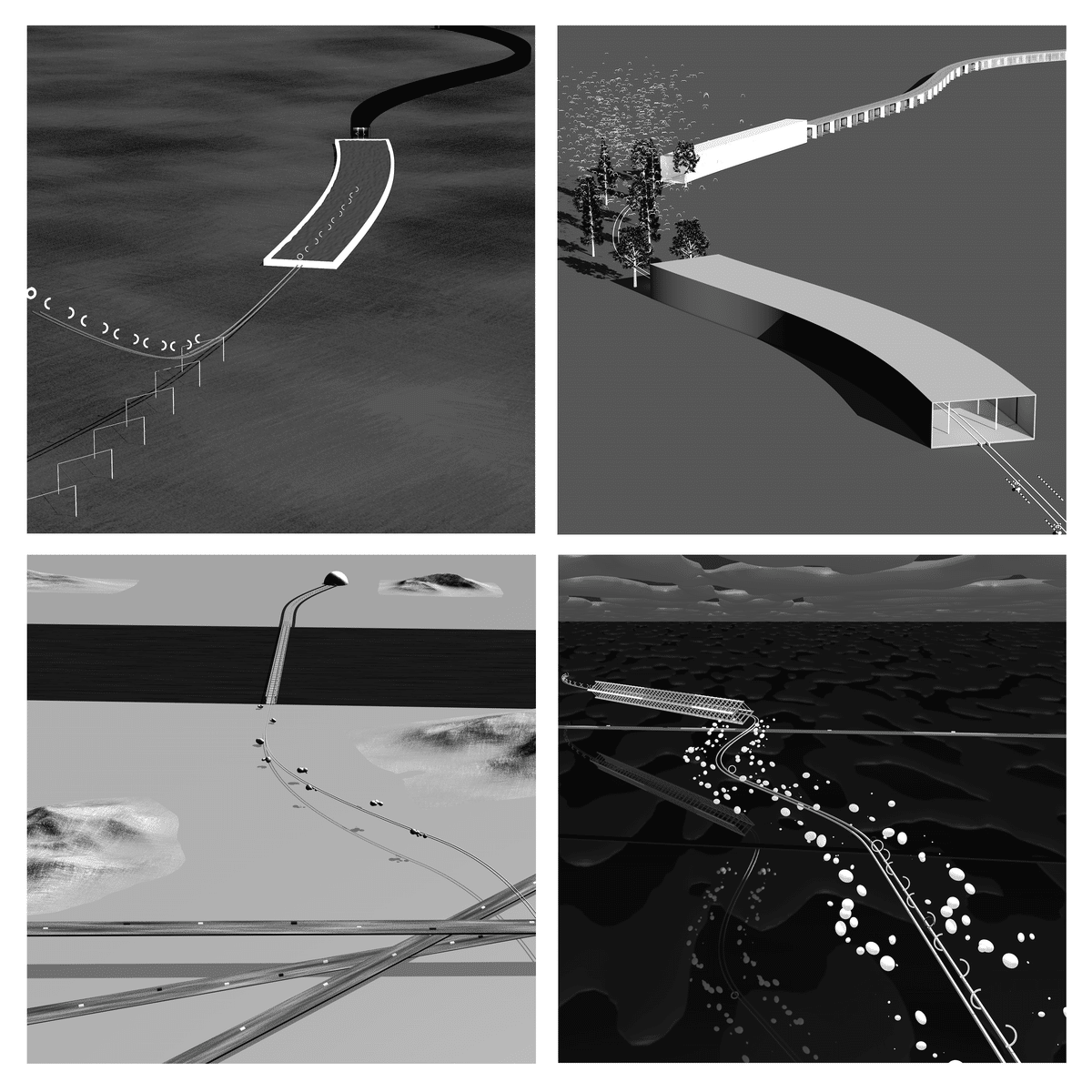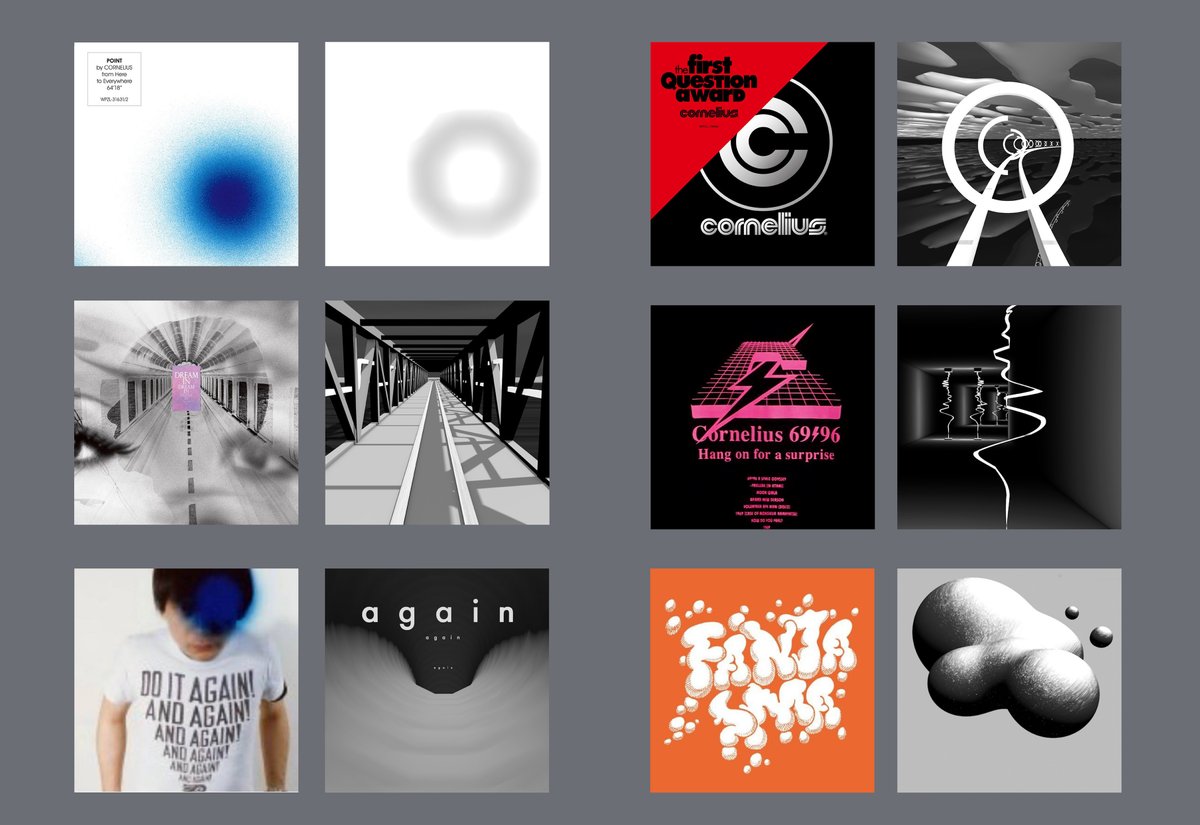
Mind Train / 音楽=電車
コーネリアス「Bad Advice / Mind Train」の12インチアナログ盤発売(2024/8/21)にあわせ、Mind TrainのMV(7/5公開)制作時に考えていたことを公開してみます。(有料設定ですが最後まで読めます)
To coincide with the release of the 12-inch vinyl of Cornelius's "Bad Advice / Mind Train" (August 21, 2024), I'm sharing some thoughts I had during the creation of the "Mind Train" music video (released on July 5). Although this is behind a paywall, you can read it all.
1. 曲の世界観 / The World of the Song
NEU!×Cornelius
この曲は明らかにドイツ'70年代のバンドNEU!(ノイ)の影響下にある。特にHallogalloという曲に顕著な、ハンマービート※1と呼ばれる"ドドカッ、ドドカッ"と進んでいくドラム。
これは、例えばHIP HOPやレゲエのように誰もが使える「汎用ビート」ともいえ、このドラムの上に反復的なギターやフワ〜ッと伸びる音を載せ、10分くらい演奏するとそれぞれのノイになる。色々なバンドがそのスタイルで曲を作ったとおもう。(90年代のStereolabとか、今聞くとすごくNEU!である)Mind Trainは「コーネリアスによるノイ」だ。本家のHallogalloは1曲を通してワンコードで、似た風景をずっと通っていく印象だが、"Mind Train"は8小節ごとに異なる場所を通り、転調や緩急があるところが大幅に違う。コーネリアスはもとより、NEU!、CAN、ハルモニアなどを聴いて育ったため、曲を聴くとそのようなことが自然にわかる。ありがたい依頼でした。
※1/モータリックビート,アパッチビートとも。これを書いている8月前半、小山田氏担当のFlag Radioにてモータリック特集があった。Spotifyのリンク 8/21時点で17〜27曲目)
NEU! × Cornelius This track is clearly influenced by the German '70s band NEU!, particularly the hammer beat, also known as the motorik beat or Apache beat, which drives the song forward with a “dodo-kat, dodo-kat” rhythm, as seen in NEU!'s song "Hallogallo."
This beat can be considered a "universal beat," like those found in hip hop or reggae, and when you add a repetitive guitar and sustained sounds over it, you get your own version of NEU! after about 10 minutes of playing. I think many bands have composed songs in this style (like Stereolab from the '90s, which sounds very NEU! when you listen now). "Mind Train" is Cornelius's take on NEU! While the original "Hallogallo" is a one-chord piece that travels through similar landscapes throughout, "Mind Train" passes through different places every eight bars, with key changes and variations in tempo, setting it apart. Having grown up listening to NEU!, CAN, and Harmonia, I naturally understood this when listening to the track. It was a delightful commission.
Note 1: There was a motorik special on the Flag Radio show, which Oyamada hosts, in early August. (Spotify link: Tracks 17–27 as of August 21).
2. ビジュアル
Motorway
NEU!的音楽につく絵を考えると、伊藤桂司「Motorway」('99)を思い浮かべないわけにいかない。高速道路を描いた物凄くかっこいいイラスト集で、発売後すぐに買って興奮した。山本ムーグ氏の解説文にノイ、ハルモニア、クラフトワークへの言及があった。バウハウスなどの手描きパースの良さも語られていた。一点透視、手描きの良さもある絵を構想しつつ、あまり似ないように念じていた。
When considering the visuals for music influenced by NEU!, I couldn’t help but think of Keiji Ito's "Motorway" ('99). It’s an incredibly cool collection of illustrations depicting highways, which I bought immediately after its release with great excitement. Moog Yamamoto's commentary referenced NEU!, Harmonia, and Kraftwerk, and also discussed the charm of hand-drawn perspectives like those from Bauhaus. While conceptualizing an illustration that captures the essence of one-point perspective and the appeal of hand-drawing, I was careful not to mimic it too closely.

サイケさ / Psychedelia
「Motorway」もサイケだが、クラフトワーク「Autobahn」にはサイケデリックなアニメーションPVがつけられていた(小山田氏におそわった)。現在のLiveで使われるモダンな映像とは異なる、キャラクターが異空間を進んでいく内容。キャラは出さないにせよ、精神の旅=マインドトレインということもあり、色々な場所を旅するやや(ジャーマン)サイケなものがよいと思っていた。
Although "Motorway" has a psychedelic quality, Kraftwerk's "Autobahn" has a psychedelic animation PV (as Oyamada told me). It’s different from the modern visuals used in their current live performances, featuring characters traveling through otherworldly spaces. Even though I didn’t include characters, the idea of a mental journey, a "Mind Train," lent itself well to a (German) psychedelic trip through various locations.
どこにもである線路 / Tracks Everywhere
道や線路は当然として、カメラが入っていける場所があれば、そこは一人称視点の線路となる。胃カメラとか獣道、塀の上、工事用パイプや遊具。ドローン競技などもあり「道」という概念はすでに地面にへばりついたものではない。いろいろ見つけて写真を撮りMind Trainの旅の参考にした。(というのは少し後付けで、作りながら面白くなって撮影したものもある)
Naturally, roads and tracks are central, but anywhere the camera can go can become a first-person perspective track. This includes endoscopes, animal trails, atop fences, construction pipes, or playground equipment. With drone racing and other developments, the concept of a "road" is no longer confined to the ground. I found and photographed various paths as references for the Mind Train journey (although this was somewhat after the fact; some shots were taken spontaneously during production).


3.音の同期 / Synchronizing Sound
音楽は電車と同じ / Music is Like a Train
Audio Architecture(※2)は楽曲中の全ての音をアニメーション化する試みだった。今回、全部は無理なので曲の構造を視覚化することを目指した。
(※2 「音のアーキテクチャ」展 9名の映像作家がCorneliusの同じ1曲を映像化する展覧会)
Audio Architecture (Note 2) was an attempt to animate every sound in a track. While that wasn’t fully achievable this time, I aimed to visualize the structure of the song.
Note 2: “Audio Architecture” exhibition where nine video artists visualized the same Cornelius track.
そもそも、音楽は電車に似ている。とくに、リズムがハネずに淡々と進むビートの音楽。一定のスピードで進み、一定の間隔で並ぶ障害物とすれ違う。並んでいるのが小節・音符か、ガードレールや橋脚かという違いがあるだけだ。したがって音楽と構造を同じくした立体空間は作りやすい。Mind Trainは1小節が4m、8小節で32mの空間を進んでいる。つまり四分音符(♩)は1mごと、八分音符(♪)は500cmごとに何かを配置しておきカメラを進行させれば、自動的に音楽と同期する。以下映像は、その説明のためにつくった。音はセルフ打ちこみです。
Music is like a train, especially rhythmically consistent beats that progress steadily. It moves at a constant speed, passing obstacles at regular intervals. The only difference is whether the obstacles are measures and notes or guardrails and bridge piers. Thus, creating a three-dimensional space that shares the structure of music is straightforward. In "Mind Train," one measure covers 4 meters, and 8 measures span 32 meters. By placing objects every meter (quarter notes) or every 500 cm (eighth notes) and moving the camera through the space, the visuals automatically sync with the music. The following videos were made to illustrate this concept.
そして、この曲は丁寧に8小節(またはその倍数)ごとに違う音が入ってくる。つまりどんどん風景が変わっていく構造であるため、空間化が非常にやりやすい。
This track introduces new sounds every eight measures (or multiples thereof), which means the scenery keeps changing, making it easy to spatialize.

実際に3D空間上に道が作ってあり、その上を走っている。以下はイントロ、別アングルから。音はありません。
The actual 3D space has a path that the camera travels along. Here’s the intro from a different angle. (No sound).
以下はその他のシーン。いわゆる「図形楽譜」は作曲者や演奏者のためのものだが、これらは聴取者のための見取り図(楽譜図形?)ともいえる。
And here are other scenes. Unlike traditional "graphic scores" for composers and performers, these are more like visual guides for listeners.

同期MV
電車もので映像と音がぴったり同期するMVの古典はミシェル・ゴンドリー「Star Guitar」だ。車窓から見える鉄柱や給水塔が、実写合成により繰り返し現れ、スネアやバスドラムに同期する。このMVの"同期感"は実は少し弱い。映像の打点というのか、楽器の発音にあわせた画面内の動きはなく、通過物が右端から出る瞬間に発音が合わせられている。通過物は大きく動いたりカメラを遮蔽したりもあまりなくただ通過していく。
A classic example of a music video where the visuals and sound are perfectly synchronized, centered around the theme of trains, is Michel Gondry’s "Star Guitar." The pillars and water towers visible from the train window repeatedly appear through live-action compositing, synchronized with the snare and bass drums. However, the "synchronization" in this music video is actually somewhat weak. This is because the movement within the frame doesn't correspond directly to the sound of the instruments; instead, the objects pass through the right edge of the screen at the moment the sound plays.
一人称視点の電車であれば、もう少し同期感がコントロールしやすく、意外にMVでそれを徹底してやっている作品は少ないかと思った。音ゲーの事例はありそうだが、あまりしらない。進行するより迎え撃つイメージ。
With a first-person perspective of a train, it would be easier to control the sense of synchronization, and I feel there are few music videos that thoroughly explore this concept. There might be examples in rhythm games, but I’m not very familiar with them.
白黒コントロール / Black and White Control
上述の同期感は通過物によるレンズ遮蔽でコントロールできる。
映像において最大の視覚的インパクトはどう生まれるか。即物的に考えるとそれは光100%の白と0%の黒の切り替えなので、(3D空間上の)カメラレンズを通過物がどの程度遮蔽するか、という加減でインパクト度が変化する。そして同期感もまた、調整可能になる。
4m先(1小節先)に障害物があったとして、同じ通過物であっても、左右に捌くか、ど真ん中にズバッとやるかなど配球した。ど真ん中であれば強い同期感を生み、コース脇にあれば、同期感は弱くなる。
The aforementioned sense of synchronization can be controlled by the lens occlusion caused by passing objects.
How does the most impactful visual effect in a video come to be? From a straightforward perspective, it’s the instantaneous switch between 100% white and 0% black. The impact level changes depending on how much an object occludes the camera lens (in a 3D space). As a result, the sense of synchronization can also be adjusted.
For example, if an obstacle is 4 meters ahead (one measure ahead), even the same passing object will produce a strong sense of synchronization if it passes through the center of the lens, whereas the synchronization will feel weaker if it passes through the edge of the lens.
こちらは制作後から試したものだが、けっこう違いがあったので音付きで見てください。
This method was tested after production, and it showed noticeable differences, so please watch with sound.
なお、スピード感はレンズの望遠/広角の具合でかわる。
The sense of speed can also be adjusted by the lens's zoom or wide-angle setting.
辻川幸一郎さんの作った「火花」MVのインタビュー*3で印象的だったのは、MVでありながら同時にライブ背景映像としての効果も考慮されていたことだった。Mind Trainもライブで使われるため、照明効果として白黒コントラストの使用を考えた。
Koichiro Tsujikawa’s interview about the “Hibana” MV was memorable because, despite being an MV, it was also designed to function as a backdrop for live performances. Since "Mind Train" is also used live, I considered the use of black-and-white contrast for lighting effects.
(*3 なおインタビューでは言及がなくSNSでも誰も言わないがMVは「火と再生」がテーマになっていることは明らかすぎる。炎上後はじめての曲であり胸を打たれた。)
手動での同期 / Manual Syncing
線路にモノを配置する以外に、どう音を表現するか。音の波形にあわせ動かすのはよくあるが、どんな音でも印象が同じになるように感じられるので基本的に避ける。波形のかたちは音の印象と一致するとは限らない。ウニョウニョするシンセ音、ノイジーなギターソロ、はじくようなギターなどは手動で動きをつくって音の印象と合わせた。音色やシンセでいうADSR(アタック、ディケイ、サスティン、リリース)のような部分を動きに変換することは感覚的にできるし、仕事するほどに音と映像があってくるので好きな作業です。
Aside from placing objects on tracks, how else can sound be expressed? Moving to match the waveform is common, but it often results in similar impressions for any sound, so I generally avoid it. The waveform shape doesn’t always match the sound's impression. Wobbly synth sounds, noisy guitar solos, and plucked guitar notes were animated manually to match their sound's impression. Converting elements like timbre or a synth's ADSR (attack, decay, sustain, release) into movement can be done intuitively, and the more I work, the better the sound and visuals align, making it a process I enjoy.

4.その他 / Other Thoughts
確認のない制作 / Production Without Storyboards
たくさん人が関わるCMや映画は絵コンテを作り、承認や現場での確認に使用するのが必須だが、今回は絵コンテを描かずに制作をはじめられた。小節数にあわせた線路を1本描き、登場する空間を埋めていったが、何が出てくるか最後まで未定の部分もあった。コンテを描きおわらないうちに作画がはじまる宮崎駿形式の作り方になり、結果的には最初に戻るような終わり方になった。出来たものを見ながら次を考えるサイクルは創造的な意味で利点がある。はじめから終わりまでコンテで全て決めてしまうと、制作が作業的になるデメリットもある。今回はこのような進め方ができ快適であった。途中のチェックがなく、ただ信任があるだけ、という仕事をさせてもらえありがたいです。
In commercials and films involving many people, storyboards are essential for approvals and on-site checks. However, this time, I was able to begin production without a storyboard. I drew a single railway track according to the number of measures and created the 3D space in the order that ideas came to me, matching it to different parts of the music. There were even sections where the final space was not decided until the end of the production. This approach was similar to that of director Hayao Miyazaki, where animators start drawing before the storyboard is complete. This cycle of creating something, reviewing it, and then deciding what to make next has creative advantages. If everything is predetermined by a storyboard from the start, the production can begin to feel like mere labor. It was refreshing to work without mid-process checks and to rely solely on trust. I'm grateful for having had this opportunity.
サブリミナル / Subliminal
Mind Trainは7月に公開され、Cornelius30周年ツアー(東京、京都)で初演された。曲に対して、過去のキャリアがつまった曲だと感じた人もいたようだ。試しに過去のジャケとMVの要素を強引に紐付けしてみたら意外とハマった。実際に意図したのはわずかな部分(DO IT AGAIN)だけれど、潜在意識が働いた可能性もそこはかとなく感じる。
Mind Train was released in July and premiered during Cornelius's 30th-anniversary tour in Tokyo and Kyoto. Some listeners felt that the track encapsulated his past career. As an experiment, I tried linking elements from past album covers with those in the music video I created, and they surprisingly matched well. While only a small portion was intentional, I suspect that my subconscious, as a longtime Cornelius fan, might have influenced the design.

プレイリスト / Playlist
最後におまけです。自分もSpotifyで、MIND TRAINプレイリストを作り聴きつつ作った。よろしければどうぞ。
Lastly, as a little bonus, I created a MIND TRAIN playlist on Spotify, which I listened to while working on the project. Feel free to check it out if you’d like.

以上です。
なお有料設定にしていますが以下は何もありません。MVは印税が発生しない仕事ですので応援してくだされば喜びます。
Note
Just to let you know, I’ve set up a paid option, but there’s no additional content. Since this music video doesn’t generate royalties, I’d be thrilled if you could support me in any way you can.
ここから先は
¥ 300
この記事が気に入ったらサポートをしてみませんか?
